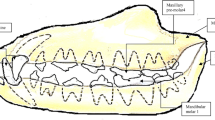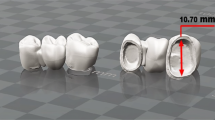Abstract
This study highlights the comparison of dental crowns prepared by fused deposition modelling (FDM) assisted chemical vapour smoothing (CVS) and silicon moulding (SM) process from roughness (Ra), accuracy (∆d) and hardness (SH) viewpoint. The functional prototypes as dental crowns have been prepared independently in two stages. In the first stage, effect of CVS, part density and orientation in FDM (with acrylonitrile-butadiene-styrene (ABS) thermoplastic) as digital manufacturing tool on output parameters (Ra, ∆d and SH of dental crowns as functional prototype from assembly view point) have been investigated. In second stage, SM process has been used for making replicas of dental crowns (prepared in first stage). The process parameters selected for SM are: de-moulding time, hardener proportion in weight percentage and curing temperature. Further, ANOVA has been employed for both stages from multifactor optimization point of view. Further, optimized process parameters of stage one and stage two were counter verified and compared for third stage of investment casting (IC).
Access this chapter
Tax calculation will be finalised at checkout
Purchases are for personal use only
Similar content being viewed by others
References
Pandey A, Singh G, Singh S, Jha K, Prakash C (2020) 3D printed biodegradable functional temperature-stimuli shape memory polymer for customized scaffoldings. J Mech Behav Biomed Mater, 103781
Cheah CM, Chua CK, Lee CW, Feng C, Totong K (2005) Rapid prototy** and tooling techniques: a review of applications for rapid investment casting. Int J Adv Manuf Technol 25(3–4):308–320
Sood AK, Ohdar RK, Mahapatra SS (2010) Parametric appraisal of fused deposition modelling process using the gray Taguchi method. Proc Inst Mech Eng Part B J Eng Manuf 44:135–145
Chhabra M, Singh R (2011) Rapid casting solutions: a review. Rapid Prototy** J 17(4)
Anitha R, Arunach AS, Radhakrishnan P (2001) Critical parameters influencing the quality of prototypes in fused deposition modelling. J Mater Process Technol 118:385–388
Armillotta A (2013) Assessment of surface quality on textured FDM prototypes. Rapid Prototy** J 12:35–41
Kumar R, Singh R, Hui D, Feo L, Fraternali F (2018) Graphene as biomedical sensing element: state of art review and potential engineering applications. Compos B Eng 134:193–206
Bassoli E, Gatto A, Luliano L, Violentte MG (2007) 3D printing technique applied to rapid casting. Rapid Prototy** J 13:148–155
Ma S, Gibson I, Balaji G, Hu QJ (2007) Development of epoxy matrix composites for rapid tooling applications. J Mater Process Technol 192(193):75–82
Chen L, He Y, Yang Y, Niu S, Ren H (2016) The research status and development trend of additive manufacturing technology. Int J Adv Manuf Technol. https://doi.org/10.1007/s00170-016-9335-4
Singh S, Singh G, Prakash C, Ramakrishna S (2020) Current status and future directions of fused filament fabrication. J Manuf Process 55: 288–306
Rodriguez JF, Thomas JP, Reynaud JE (2001) Experimental investigations Mechanical behaviour of acrylonitrile butadiene styrene (ABS) fused deposition materials. Rapid Prototy** J 7(3):148–158
Bhargav A, Sanjairaj V, Rosa V, Feng LW, Fuh YH (2017) Applications of additive manufacturing in dentistry: a review. https://doi.org/10.1002/jbm.b.33961
Boschetto A, Giordano V, Veniali F (2013) Surface roughness prediction in fused deposition modelling. Int J Adv Manuf Technol 67:2727–2742
Boparai K, Singh R, Singh H (2016) Development of rapid tooling using fused deposition modelling: a review. Rapid Prototy** J 22(2)
Percoco G, Lavecchia F, Galantucci LM (2012) Compression properties of FDM rapid properties treated with a low cost chemical finishing. J Appl Sci Eng Technol 4:3838–3842
Boschetto A, Giordano V, Veniali F (2016) Modelling micro geometrical profiles in fused deposition process. Int J Adv Manuf Technol 61:945–956
Chung S, Park S, Lee I, Jeong H, Cho D (2005) Replication techniques for a metal micro-component having real 3D shape by micro casting process. Microsys Technol 11:424–428
Galantucci LM, Lavecchia F, Percoco G (2009) Experimental study aiming to enhance the surface finish of fused deposition modeled parts. Ann Manuf Technol 58:189–192
Garg A, Bhattacharya A, Batish A (2015) On surface finish and dimensional accuracy of FDM parts after cold vapour treatment. Mater Manuf Process 1–24
Gurrala PK, Regalla SP (2014) Part strength evolution with bonding between filaments in fused deposition modelling. Virtual Phys Prototy** 141–149
Gao H, Kaweesa VD, Moore J, Meisel AN (2016) Investigating the impact of acetone vapor smoothing on the strength and elongation of printed ABS parts. Miner Metals Mater Soc. https://doi.org/10.1007/s11837-016-2214-5
Zinniel RL (2011) Vapour smoothing surface finishing system. U.S. Patent No. 8075300 B2
Singh J, Singh R, Singh H (2016) Repeatability of linear and radial dimension of ABS replicas fabricated by fused deposition modelling and chemical vapour smoothing process: a case study. Measurement 94:5–11
Kuo CC, Liu LC, Teng WF, Chang HY, Chien FM, Liao SJ, Kuo WF, Chen CM (2016) Preparation of starch acrylonitrile-butadiene-styrene copolymers (ABS) biomass alloys and their feasible evaluation for 3D printing applications. Compos Part B 86:36–39
Singh J, Singh R, Singh H (2017) Investigations for improving the surface finish of FDM based ABS replicas by chemical vapour smoothing process: a case study. Assembly Autom 37(1):13–21
Dinesh P, Ravi R (2007) Rapid tooling route selection and evaluation for sand and investment casting. Virtual Phys Prototy** 2:197–207
Kuo CC, Mao CR (2015) Development of a precision surface polishing system for parts fabricated by fused deposition modeling. Mater Manuf Process. ISSN: 1042-6914
Singh J, Singh R, Boparai KS (2016) Parametric optimization of fused deposition modelling and vapour smoothing processes for surface finishing of biomedical implant replicas. Measurement 94:602–613
Kai CC, Howe CT, Hoe EK (1998) Integrating rapid prototy** and tooling with vacuum casting for connector. Int J Adv Manuf Technol 14:617–623
Thian SCH, Tang Y, Tan WK, Fuh JYH, Wong YS, Loh HT, Lu L (2008) The manufacture of micro mould and micro parts by vacuum casting. Int J Adv Manuf Technol 38:944–948
Singh R, Singh B (2010) Process capability of rapid manufacturing for plastic components. LAP Lambert Academics Publication Germany. ISBN 978-3-8433-8735-4:76
Rahmati S, Akbari J, Barati E (2007) Dimensional accuracy analysis of wax patterns created by RTV silicon rubber molding using Taguchi approach. Rapid Prototy** J 13(2):115–122
Tang Y Tan, Fuh WK, Loh JYH, Wong HT, Thian YS, Lu SCH (2007) Micro mould fabrication for micro-gear via vacuum casting. J Mater Process Technol 192–193:334–339
Sharma V, Singh R (2011) Investigations for modelling the silicon moulding process for plastic components. Int J Mater Sci Eng 2(1–2)
Author information
Authors and Affiliations
Corresponding author
Editor information
Editors and Affiliations
Rights and permissions
Copyright information
© 2020 Springer Nature Singapore Pte Ltd.
About this chapter
Cite this chapter
Singh, R., Singh, R., Dureja, J.S. (2020). Dental Crowns by FDM Assisted Vapour Smoothing and Silicon Moulding. In: Singh, S., Prakash, C., Singh, R. (eds) 3D Printing in Biomedical Engineering. Materials Horizons: From Nature to Nanomaterials. Springer, Singapore. https://doi.org/10.1007/978-981-15-5424-7_11
Download citation
DOI: https://doi.org/10.1007/978-981-15-5424-7_11
Published:
Publisher Name: Springer, Singapore
Print ISBN: 978-981-15-5423-0
Online ISBN: 978-981-15-5424-7
eBook Packages: Chemistry and Materials ScienceChemistry and Material Science (R0)




